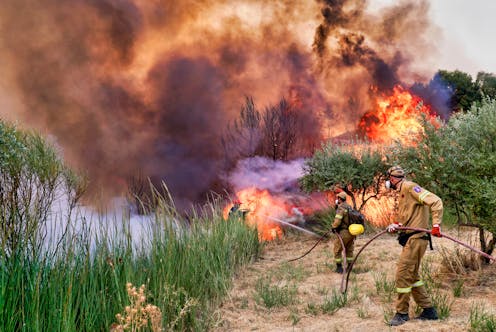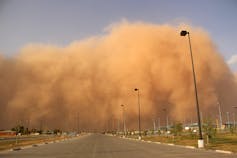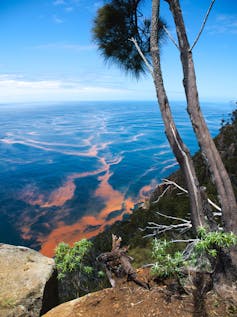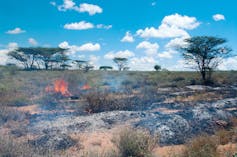
Wildfires affect large areas of the Earth’s surface and many of their effects occur at an alarming speed. The fires that consumed half of Australia’s Kangaroo Island in 2019 left a trail of animal corpses in their wake. In 2021, wildfires burned over 2.5 million acres of land in California.
But wildfires have other harmful effects that are slower to materialise. Wildfires reduce vegetation cover and can damage soil to the extent that it retains less moisture. As wind blows over the scarred landscape this can lead to the increased release of dust made from fine mineral grains (often less than 0.01 mm in diameter).
The wind lifts the dust emissions into the air where they can find themselves suspended in a global atmospheric process that transfers them around the world. Dust events can therefore affect areas far from the land close to a wildfire.
Scientists have long established that concentrations of atmospheric dust increase following large wildfires. But the global extent of post-fire dust events has been an underresearched aspect of the study into the impact of wildfires. Now researchers from Peking and Princeton universities have identified that the duration and scale of post-fire atmospheric dust storms may be far greater than previously understood.
Larger dust storms
Using two decades of satellite observations, the researchers found that over 150,000 large wildfires had occurred worldwide between 2003 and 2020. At least 20 1km by 1km squares within an area of approximately 100km² had to include detectable fires for at least seven consecutive days for a fire event to be defined as a large wildfire.

Over half of the large wildfires identified were followed by dust events. In these events, the concentration of atmospheric dust in the area surrounding the fire-affected region increased more than threefold on average.
Most of the dust storms continued for a few days after a fire. But in 10% of the events occurring in savannah and grassland areas, dust concentrations were still exceptionally high ten days later and occasionally more than three weeks after the fire.
Across the period of study, the researchers found that the duration of post-fire dust events increased significantly. A dust event that occurred in 2020 lasted 24 hours longer on average than it did in 2003.
Should we be concerned?
Atmospheric dust storms can have serious impacts on ecology and human health.
Dust emissions are rich in chemical nutrients including phosphorus, nitrogen and iron. Nutrients such as these are key elements of soil productivity. As the nutrient-rich top layer of soil is removed by wind, soil quality in the area affected by a fire is depleted.
But dust can also be transported vast distances via the global dust cycle. When deposited, nutrient-rich dust emissions can fertilise soils and oceans far from the affected area.

Research has linked Australia’s wildfires in 2019–2020 to extensive phytoplankton blooms in the Southern Ocean. Dust emissions can provide phytoplankton with the nutrients needed for rapid growth, leading to the formation of blooms. Such blooms can harm local marine ecosystems by reducing the oxygen content of the water.
Smoke is an obvious health concern associated with wildfires. Small, inhalable, coarse particles within smoke can cause respiratory damage. Research links airborne particulate matter to over two million deaths worldwide each year.
Fine dust particles are even smaller (2.5 micrometres in diameter) and pose a similar threat. The researchers suggest that the risks posed by large wildfires to human health may extend well beyond the immediate plume of smoke and may continue long after the smoke has cleared.
Does climate change have a role?
It might be tempting to ascribe the observed increase in the duration of post-fire dust events to our warming climate. Climate change can make hot and dry weather conditions more common and create the conditions for dangerous wildfires.
Yet the researchers are cautious to adopt this explanation. They note only that enhanced dust emissions correlate with the number of previous fires at a given location.

Fire is a natural part of many ecosystems and evidence for increasing wildfire frequency is complex. Savannah ecosystems, which the study identifies as the landscape most prone to post-fire dust emissions, owe their existence to the presence of fire. Regular fires remove young trees and return the grassland community to its original state.
Determining whether a wildfire has been caused by direct human actions or climate change is also difficult. Just as for climate change, human actions can influence wildfire activity. The use of fire to burn farming or logging residue, for example, increases the risk of wildfire.
Scientists increasingly understand that wildfires are a feature of the natural world. But their impacts can be dangerous and extend well beyond the margins of the fire itself.
Matt Telfer does not work for, consult, own shares in or receive funding from any company or organisation that would benefit from this article, and has disclosed no relevant affiliations beyond their academic appointment.
This article was originally published on The Conversation. Read the original article.







